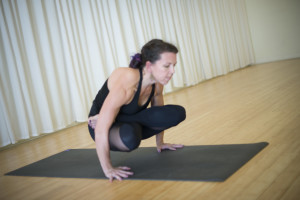Mūla bandha, also known as the root lock, can be elusive and hard to connect to. Personally, over my 14+ years of practice, I have continually reconnected/refined/re-found mūla bandha over and over again. Mūla Bandha helps to provide control over your center of gravity and helps you feel steady and stable in physical yoga postures. Physically, it also helps to ensure your body is rooted in healthy alignment as you approach movements and allows you to tap into profound strength and steadiness from within. Mūla bandha facilities the initiation of movement from the midline of the body and helps to keep you safe while you are navigating poses on their mat.
Additionally, the muscular engagement of mūla bandha seals off the bottom of the tube of the torso and inhibits the downward energetic pattern of apana and creates the potential for energetic healing within.
Mūla bandha is crucial to all aspects of our yoga practice and spiritual journey. Engagement of mula bandha is useful in emotional, stressful or uncertain times as it helps practitioners activate and connect to mūlādhāra cakra, and brings about a sense of groundedness and stability.
There’s a lot going on with this bandha engagement. Mūla bandha calls on three separate actions for complete engagement:
- Aśvini mudra – contracting the anus
- Mūla bandha – contracting the perineum
- Vajroli mudra – contracting the urogenital area
Many practitioners find the engagement of mūla bandha to be an evolutionary process of refinement and reconnection over years of practice and experience. The intensity and/or location of mūla bandha activation can change relative to the needs of the current practice and/or positioning of the pelvis.
Advice for finding, feeling and experience mūla bandha:
- Try contracting the whole pelvic floor, and as often as possible.
- Try to imagine the diamond shape created between your pubic bone, tailbone and two ischial tuberosities. When relaxed, the tissue that webs these four pints together is soft, like a hammock. When contracted, the tissue is taught, like a trampoline.
Mūla bandha is safe to practice any time EXCEPT:
- While going to the bathroom
- When a woman is on her menstrual cycle
- When a woman is in active labor
- Mūla bandha is not necessary to focus on while sleeping
All other times – MŪLA BANDHA ON!
Directions to engage mūla bandha
- Sit in a comfortable meditative posture with the pelvis upright
- Close the eyes and find softness throughout the body
- Feel the breath natural and effortless
- Allow your awareness to shift to the pelvic region
- Take three rounds of breath inhaling for a count of 3-4 and exhaling for a count of 3-4
- Contract the muscles of the pelvic floor as you inhale for a count of 3-4 and then relax them as you exhale for a count of 3-4
- Continue this rhythm of contraction and release with breath and continual awareness for five rounds
- Inhale for a count of 3-4 with mūla bandha released and then contract the muscles of the pelvic floor as you exhale for a count of 3-4
- Continue this rhythm of contraction and release with breath and continual awareness for five rounds
- Contract the muscles of the pelvic floor as you inhale for a count of 3-4 and then keep them contracted as you exhale for a count of 3-4
- Continue this rhythm of breath with contraction of mūla bandha for five rounds
- Take three rounds of breath inhaling for a count of 3-4 and exhaling for a count of 3-4
It is always best to work directly with an experienced teacher to help support your physical, emotional and spiritual journey in yoga. If you ever start to feel overwhelmed, un-safe or experience pain with this exercise please connect with your teacher to help guide you directly and safely.

* About Jessica
You Might Also Enjoy:
- Ashtanga, Pregnancy and That First Year
- Truth Matters
- Always Looking, Never Seeing
- Returning to the Mat
- Yoga Doesn’t Really Mean Union
- Three Gifts
- What Does It Really Mean To Practice Non-Attachment
- Ashtanga Opening Mantra
- Yoga To Sleep Better At Night
- Some Truth About Ashtanga Yoga
- Yoga Brings Out The Worst In Me
- Catvāri cringe
- Into The Shadows – the elusive search for happiness in Ashtanga Yoga
- …and in all earnestness
- Ashtanga Yoga and the Ego
- Guru Gratitude
- 5 Ways to Find Joy, Even When You’ve Got The Grumps
- The Grateful Game
- Yoga And The Quest To Know It All
- Standing Up From Backbending – How I Overcame My Fears
- Keeping Guruji With You When You Practice
- The Heart of Ashtanga Yoga: The Tristhana Method
- Ashtanga Yoga is a Breath Practice. Seriously, It REALLY Is
- The Seven Words that Changed My Practice

